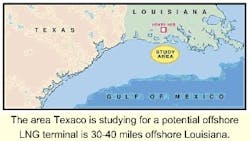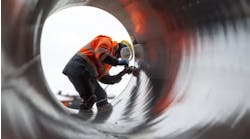Texaco looking at LNG on US Gulf shelf
The area Texaco is studying for a potential offshore LNG terminal is 30-40 miles offshore Louisiana.
With the decline in gas production in the Gulf of Mexico, Texaco hopes to maintain delivery in its existing pipeline infrastructure with gas transported from other regions. With this in mind, the producer is also looking at liquefied natural gas (LNG) technology, which allows specially designed tankers to transport a large amount of gas in a liquid state.
Texaco is weighing the advantages of establishing an LNG terminal 30 to 40 miles offshore Louisiana. This facility would be located in 70-90 ft water depth and could re-gasify the LNG for transport to shore via existing and new Texaco pipelines. The LNG terminal may be a floating facility or a fixed-bottom jacket structure.
The new pipelines from the facility would tie into existing lines that Texaco says are currently under utilized. Once the gas reaches shore, it would provide feedstock for Texaco transport lines, including the Henry Hub interstate pipeline system.
The study, which began recently and will run about six months, will look at the cost and infrastructure requirements for such a project. Texaco said the terminal would be designed to initially process 1 bcf of LNG per day. Project planners are designing the facility with the ability to expand capacity to double the initial level, if it is justified by future market demand. If the study shows a project should go forward, Texaco estimates it could be operational within five years.
Currently, there are four US LNG terminals in operation, but this would be the first in the Gulf of Mexico. According to Texaco, the existing terminals are all working at or near capacity. With the increase in both gas demand and price, Texaco hopes this facility would make better use of infrastructure already in place. The new facility would receive production from one or several Texaco projects in the Atlantic Basin. Trinidad is in the process of bringing several LNG trains on line to transport the country's increasing gas production.
FMC onboard for Bijupera-Salema
Enterprise Oil has awarded FMC's Brazilian company CBV the subsea hardware contract for what will be the first deepwater development project offshore Brazil that is run by a foreign operator. The contract includes the design and construction of four manifolds, one of which will be used for water injection. A single, four-slot production manifold will be installed on the Salema, located in 2,165 ft water depth.
The other two four-slot manifolds and the four-slot water-injecting manifold will be installed on Bijupera, in 2,460-ft water depth, about three miles away. The wells from both the Bijupera and the Salema will be tied back to a floating production, storage, and offloading vessel, to be built by Modec, and partially owned by FMC. The FPSO will be moored in 2,300-ft water depth about halfway between the two fields and features a turret system provided by Sofec. Kongsberg Offshore will provide the controls system on this project.
ABB trees Korea contract
Korea National Oil Company (KNOC) will use use ABB horizontal tree systems for the Donghae-1gas project, the company's first offshore development. Donghae-1 is located in 492 ft water depth in the East Sea 36 miles off Korea's southeast coast. The contract, placed with ABB Vetco Gray Singapore, covers three diverless horizontal tree systems with trees, flowbases, tubing hangers, and internal tree caps. ABB will provide and test interfaces between the tree systems and other equipment. ABB will provide installation support offshore and well as operations and project support. The wells will be tied back to a production platform one mile away.
Wellstream lands Boomvang contract
Kerr-McGee recently awarded Wellstream two contracts for Nansen and Boomvang. The first, direct from Kerr-McGee, is for the system design and supply of 5.625-in., 6,000-psi flexible pipe production risers and tie in jumpers for the project. The risers will be installed in a catenary configuration on the Nansen and Boomvang spars for infield production, and will enable the operator to offset the spars for future on-site drilling.
The tie-in jumpers will connect rigid flowlines and subsea trees. Wellstream said its ability to significantly reduce offshore construction and installation time was a major factor in the decision to use its flexible tie-in jumpers. Wellstream will manufacture these risers and jumpers at its Panama City, Florida, facility for delivery in August.
The second contract, from Bridon Intl Ltd, is for the extrusion of HDPE sheathing on the wire spiral strand to be used for the Boomvang and Nansen spar moorings. Bridon was awarded the wire rope contract by CSO-Aker Rauma Offshore as part of their supply contract to Spars International Inc.
This sheathing increases the design life of the steel mooring ropes to over 20 years by providing an abrasion resistant barrier against water ingress and subsequent corrosion. The cables will be manufactured at Bridon's Doncaster, UK, facility. The cables will be sheathed at Wellstream's Newcastle upon Tyne, UK facility. This facility has made modifications to extrusion equipment and reel handling capability to facilitate this process.
Boomvang partners expand relationship
Ocean Energy and Kerr McGee Oil and Gas, partners on the development of Boomvang, expanded their relationship to conduct joint exploration and development of oil and gas prospects on 181 deepwater blocks in the Gulf of Mexico. Of the more than a million gross acres covered in the agreement, Ocean Energy holds interests in 43%. The producer said a number of drilling prospects have been identified and will be drilled over the next 18 months, with drilling to begin this summer.
Ocean Energy will serve as the operator on at least 25% of the first 15 exploratory wells in a multi-year drilling program. The goal of this arrangement, according to Ocean Energy Chairman James T. Hackett, is to spread the risk and expense of a large exploration program. While the scope of this new agreement is greater, Ocean Energy and Kerr/McGee have been working together for a couple of years on the Nansen and Boomvang deepwater discoveries in the East Breaks area of the Gulf of Mexico.
The two fields will be produced with the world's first truss spars installation. Production from Nansen is expected to begin before year's end. Boomvang will come onstream in the first quarter of 2002. The two spars will have a combined production capacity of 80,000 boe and 400 MMcf/d of gas.
Severe-duty jumpers for Shell's EA field
Wellstream said it was awarded a contract to supply one, 8-in. internal diameter(ID), and three, 16-in. ID dynamic topside jumpers. The jumpers will be supplied to Single Buoy Moorings (SBM) for installation on the Shell EA field development offshore Nigeria in West Africa. The jumpers will be used to connect the field's floating production, storage, and offloading (FPSO) vessel and a soft yoke mooring platform (SYMP). Once installed, these jumpers, with a 16-in. ID, will become the largest diameter flexible pipes yet to be produced by Wellstream. These and previous flexible products were built at Wellstream's manufac-turing facility in Newcastle upon Tyne. The jumpers are scheduled for delivery in June of next year. Wellstream said the jumpers have been designed to withstand the operational conditions imposed by close proximity to the flare stack and suited to fight off degradation from prolonged exposure to ultraviolet radiation.




